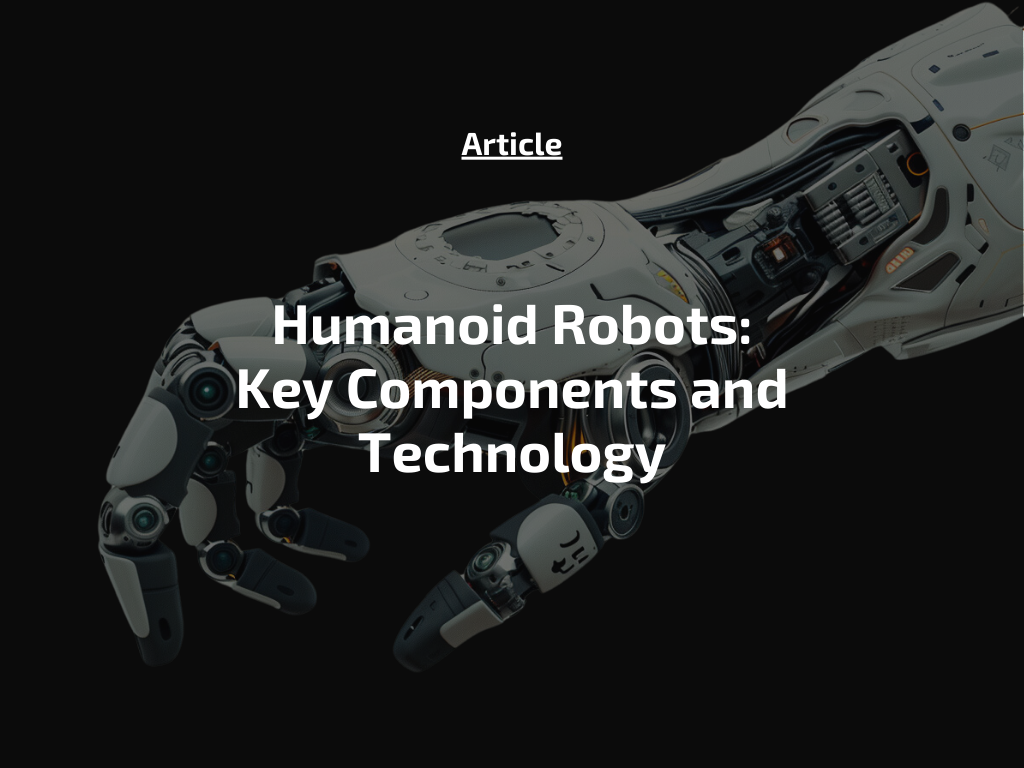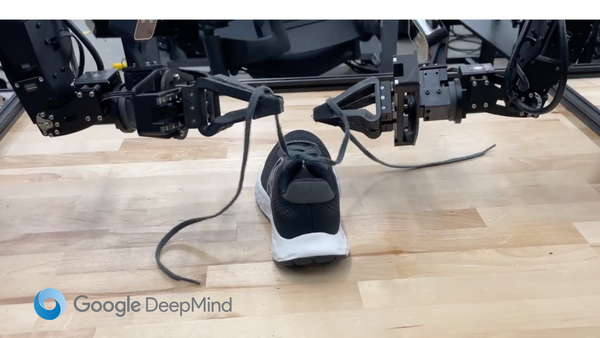Key Components Shaping the Humanoid Robot Market
Understand the essential technologies powering humanoid robots. Explore actuators, sensors, control systems, and more. Learn how they’ll influence robot costs and capabilities.

Part of understanding the market is examining the components and technology used to develop a humanoid robot. These will impact the quality, cost, supply chain, and aftermarket services.
Those areas must continue to mature for the humanoid market to meet expectations. There’s a potential shift from hydraulic to electric-powered, costs are too high, the supply chain is evolving, and aftermarket services aren’t fully developed or understood.
Plus, everyone knows that underlying technology and software are evolving fast. I’ve done my best to put together an initial list of suppliers. Many are missing, so I’ll update as I research and analyze the market. And I’ll use the information to feed into my deeper analysis and reports.
What Is a Humanoid Robot
But before we jump into the technology, we must define what we mean by a humanoid robot. So, let's keep it simple.
A humanoid robot resembles a human, can operate in the human environment, perform multiple tasks, receive instruction, and continue to learn.
Now that we know what a humanoid robot is, we can talk about its underlying technology.
Actuators
- Function: Convert energy into mechanical motion to enable the robot's joints and limbs to move. Common types include electric motors, hydraulic actuators, and pneumatic actuators.
- Influence on Capabilities: Determine how smoothly and accurately a robot can mimic human movements such as walking, grabbing, or turning. Hydraulic actuators provide high force and precise control but can be bulky and noisy, while electric motors offer cleaner and more flexible operations.
- Potential Suppliers: Maxon Motor, Harmonic Drive, ElectroCraft, SCHUNK, Festo, Hiwin
Servos
- Function: Incorporate a motor, a sensor for position feedback, and a control unit to precisely control angular or linear position, velocity, and acceleration.
- Influence on Capabilities: Critical for finer control of movements, such as hands or facial expressions, allowing the robot to perform complex tasks requiring high precision.
- Potential Suppliers: Hiwin, ServoCity, Robotis, Futaba, Dynamixel

Sensors and Feedback Systems
- Function: Collect data about the robot’s environment and state. This information is crucial for the actuators and servos to function correctly and provides the necessary feedback for motion adjustments.
- Influence on Capabilities: Integrating sensors with actuators and servos enhances a robot’s ability to interact with its environment in a more human-like manner. For example, touch sensors can allow the robot to adjust the grip on an object based on how hard or soft it is.
- Potential Suppliers: Honeywell, Bosch, TE Connectivity, STMicroelectronics, OMRON, Broadcom
Control Systems
- Function: Control systems interpret the inputs from sensors and direct the actuators and servos to perform actions. They use algorithms and models to manage the robot’s posture, balance, and motion.
- Influence on Capabilities: The sophistication of the control system determines how well a robot can perform tasks requiring balance and coordination, such as walking on uneven terrain or dancing.
- Potential Suppliers: NVIDIA, Intel, Texas Instruments, Analog Devices, Bosch
Joints
- Function: Joints connect various parts of the robot's body, such as arms, legs, and head, facilitating articulated movement similar to human joints.
- Influence on Capabilities: The design of the joints affects the robot's range of motion and the fluidity of its movements, enabling more complex, human-like actions that enhance interaction and task performance.
- Potential Suppliers: Igus, RoboDK, VEX Robotics, Harmonic Drive Technologies, SCHUNK
Gear Systems
- Function: Gears transmit torque and adjust the speed between the robot's moving parts, ensuring precise motion control in actuators and motors.
- Influence on Capabilities: Precision gear systems are critical for smooth and controlled movements and crucial for performing high accuracy and stability tasks.
- Potential Suppliers: Harmonic Drive, Wittenstein, Nabtesco, NSK (Nippon Seiko Koki), Shimpo
Structural Components
- Function: These include the robot’s frame and body panels, which are typically made from lightweight materials such as aluminum or advanced composites and provide structural support.
- Influence on Capabilities: The durability, strength, and weight of these materials directly affect the robot’s operational efficiency, allowing for greater mobility and longer operational periods without compromising structural integrity.
- Potential Suppliers: Alcoa, Toray Industries, Carpenter Technology Corporation, Mitsubishi Chemical Holdings Corporation, Owens Corning
Power Supply Systems
- Function: These systems manage the distribution and storage of energy necessary for the robot's operations, typically incorporating batteries and power management circuits.
- Influence on Capabilities: A robust power supply maintains consistent performance. It affects how long the robot can operate and how effectively it manages energy consumption during intensive tasks.
- Potential Suppliers: Panasonic, Samsung, LG Chem, Toshiba, BYD Company
Cooling Systems
- Function: Cooling systems mitigate the heat generated by the robot’s internal components, such as motors and electronic circuitry, which is crucial for maintaining optimal operating temperatures.
- Influence on Capabilities: Efficient cooling ensures the robot’s performance remains stable and reliable, particularly during prolonged or high-power operations. It prevents overheating, which could lead to hardware malfunctions.
- Potential Suppliers: Aavid Thermalloy, Molex.

Wiring and Electrical Circuitry
- Function: This network of electrical components connects sensors, actuators, control units, and power systems, ensuring that electrical signals are conveyed accurately throughout the robot.
- Influence on Capabilities: Properly designed and implemented wiring is crucial for reliable system communication, directly impacting the robot’s responsiveness and coordination during complex maneuvers.
- Potential Suppliers: TE Connectivity, Molex.
Communication Interfaces
- Function: This function enables the robot to communicate with external devices or networks, essential for IoT connectivity and remote operations.
- Influence on Capabilities: Enhances the robot's functionality in connected ecosystems by allowing it to exchange data and commands seamlessly with other systems, thereby increasing its operational flexibility and integration capabilities.
- Potential Suppliers: Cisco Systems, Qualcomm.
Software and Firmware
- Function: This consists of the software that runs on humanoid robots, which includes operating systems, applications, and firmware embedded within hardware components.
- Influence on Capabilities: Determines the robot’s ability to perform complex tasks, update functionalities, and integrate new features seamlessly. Advanced software enables sophisticated decision-making, learning abilities, and adaptation to new tasks and environments.
- Potential Suppliers: Microsoft, NVIDIA, Open AI, and Google.
Vision Systems
- Function: It comprises cameras and visual processing units that allow the robot to perceive its environment visually, which is essential for tasks requiring image recognition and spatial awareness.
- Influence on Capabilities: Vision systems are critical for navigation, object recognition, and complex environmental interactions. They enable robots to understand and interact with their surroundings more effectively, facilitating autonomous operations in varied settings.
- Potential Suppliers: Sony, Intel.
Artificial Muscles
- Function: Some advanced robotic systems use synthetic materials that mimic the contraction and expansion of natural muscles to produce more natural and fluid movements.
- Influence on Capabilities: These components offer smoother, lifelike movements, significantly reducing the mechanical noise and wear associated with traditional actuators. They allow humanoid robots to move in ways that closely resemble human motion, which is particularly beneficial for applications requiring interaction with people.
- Potential Suppliers: Artimus Robotics, but most in R&D/Universities
Exploring core components and technologies highlights the intricate relationship between engineering and the evolving humanoid robot market. As these technologies mature, so will the capabilities and potential applications of humanoid robots.
Addressing cost reduction, supply chain optimization, and aftermarket development are crucial hurdles to overcome. This list serves as a starting point, continuously evolving alongside the dynamic field of humanoid robotics.



